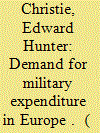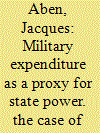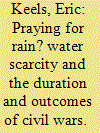| Srl | Item |
| 1 |
ID:
164520


|
|
|
|
|
| Summary/Abstract |
A variant of established work on the demand for military expenditure is developed based on a practical concept of fiscal space from the perspective of short-term government choices concerning public expenditures. A new indicator, referred to as fiscal capacity, is defined and used as a candidate explanatory variable in an empirical model of European defence spending over the 2007–2016 period. Fiscal capacity is found to outperform simpler measurements of economic conditions, notably GDP growth forecasts, in explaining changes in defence spending efforts as a share of GDP. Regarding security environment variables, the results suggest that Russia has recently come to be seen as a potential military threat by European nations, leading to defence spending increases, the more so the shorter the distance to stationed or deployed Russian forces, and particularly so by those European nations that have a land border with Russia. A prospective exercise is then carried out in order to assess the capacity of EU member states that are also members of NATO to reach NATO’s 2% goal for defence spending over a mid-term horizon.
|
|
|
|
|
|
|
|
|
|
|
|
|
|
|
|
| 2 |
ID:
164519


|
|
|
|
|
| Summary/Abstract |
This paper examines the link between ethnic segregation and domestic terrorism. The results show that ethnic segregation has a positive and significant effect on the incidence of domestic terrorism, which indicates that countries where ethnic groups are spatially concentrated face a higher risk of suffering this type of violence. This finding is not affected by the inclusion in the analysis of different covariates that may affect both ethnic segregation and domestic terrorism. The observed relationship between the degree of spatial concentration of ethnic groups and domestic terrorism is confirmed by various robustness tests. The results also suggest that the threat of secession is an important transmission channel linking ethnic segregation and domestic terrorism.
|
|
|
|
|
|
|
|
|
|
|
|
|
|
|
|
| 3 |
ID:
164525


|
|
|
|
|
| Summary/Abstract |
This paper attempts to build a simple indicator of state power. Military expenditure is the paper’s point of departure, with the definitions given by NATO, SIPRI and others. This definition is discussed and a power version is build, using French budgetary data. Then a defence of the result against traditional or non-traditional critics is presented under an imperative of action. Finally, this concept is enlarged and a new concept of power expenditures is given, one more time using French budgetary data. The conclusion is that this large expenditure concept is an unbiased but imperfect indicator of the will to act, and has to be completed by GDP to indicate the capability to act in the long-run.
|
|
|
|
|
|
|
|
|
|
|
|
|
|
|
|
| 4 |
ID:
164523


|
|
|
|
|
| Summary/Abstract |
Buying off the shelf procurements (OTS) has become an important part of the national acquisition strategy in several countries, and this paper seeks to bring empirical evidence on OTS as the preferred acquisition strategy by use of data from 2015 to 2022 investment portfolio of the Norwegian Armed Forces. We develop definitions for three categories of procurement – OTS, modified OTS and development projects – as well as a method to classify projects into these categories. Our first finding is that the characteristics of OTS projects correspond to modified OTS and development projects. Our second finding indicates that OTS projects perform better when it comes to the completion of projects according to the initial schedule, compared to development projects.
|
|
|
|
|
|
|
|
|
|
|
|
|
|
|
|
| 5 |
ID:
164521


|
|
|
|
|
| Summary/Abstract |
A dynamic multi-stage decision-theoretic approach is introduced to establish the optimal offset and its incidence, the contract price arising from bargaining, and the scale of the acquisition. A new rationale is suggested for offsets in terms of their role as an insurance devise. Results are derived for the pricing of delivery contracts subject to offset claims and their national security implications. It is shown that the national security is strictly convex in the offset transaction. As to the incidence of the offset, the offset claim is shown to be capitalised in the delivery price. The bargaining price is shown to depend on the value of the product to be delivered for the national security, the relative negotiation power of the contracting partners and the social cost of public funds. The analysis highlights the expectation effects of offsets on the bargaining price and the scale of delivery. The results aid in explaining why offsets are widely used in procurement contracts for defence materiel. As they contribute to the national security, they should be allowed to survive and not be denied under competition laws.
|
|
|
|
|
|
|
|
|
|
|
|
|
|
|
|
| 6 |
ID:
164524


|
|
|
|
|
| Summary/Abstract |
The Swiss Armed Forces are suffering from a structural deficit of militia officers despite good pay and a general supportive attitude in the population. Whereas, prior studies have focused on motivation to explain understaffing in armed forces, we offer an alternative approach based on opportunity cost. We model decision alternatives both within and outside a military organization, taking private sector employment as the reference point. We then monetize opportunity costs of leisure, fringe benefits, and private sector income not compensated. Our results suggest that in terms of opportunity cost, service as a militia officer is the least attractive option, an effect that we believe explains the persistent staff deficit. Implications of these findings for the literature and recruitment policy are discussed.
|
|
|
|
|
|
|
|
|
|
|
|
|
|
|
|
| 7 |
ID:
164517


|
|
|
|
|
| Summary/Abstract |
Recent anecdotal evidence from the civil wars in Somalia and Yemen suggest that water scarcity may shape the dynamics of civil wars. While a considerable body of research has examined the connection between water scarcity (such as low rainfall) and the onset of civil war, very little research has examined how water scarcity may shape the duration and outcomes of civil wars. Looking specifically at rainfall, this paper argues that changes in access to water play a key role in the duration of civil wars. As rainfall declines, there is a reduction in resources available to both the government and the rebel group, leading to a stalemate in fighting. Furthermore, this paper argues that declines in rainfall are felt more acutely by rebel groups who seek to challenge the government through conventional warfare. This paper tests these propositions using hazard models. The results provide robust support for the propositions.
|
|
|
|
|
|
|
|
|
|
|
|
|
|
|
|